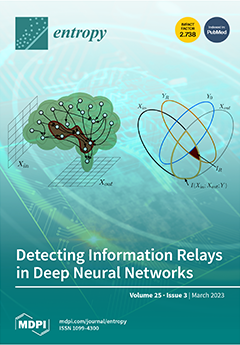In this paper, we focus on evolution from an equilibrium state in a power law form by means of
q-exponentials to an arbitrary one. Introducing new
q-Gibbsian equalities as the necessary condition of self-organization in nonextensive open systems, we theoretically show
[...] Read more.
In this paper, we focus on evolution from an equilibrium state in a power law form by means of
q-exponentials to an arbitrary one. Introducing new
q-Gibbsian equalities as the necessary condition of self-organization in nonextensive open systems, we theoretically show how to derive the connections between
q-renormalized entropies (
) and
q-relative entropies (
) in both Bregman and Csiszar forms after we clearly explain the connection between renormalized entropy by Klimantovich and relative entropy by Kullback-Leibler without using any predefined effective Hamiltonian. This function, in our treatment, spontaneously comes directly from the calculations. We also explain the difference between using ordinary and normalized
q-expectations in mean energy calculations of the states. To verify the results numerically, we use a toy model of complexity, namely the logistic map defined as
, where
is the map parameter. We measure the level of self-organization using two distinct forms of the
q-renormalized entropy through period doublings and chaotic band mergings of the map as the number of periods/chaotic-bands increase/decrease. We associate the behaviour of the
q-renormalized entropies with the emergence/disappearance of complex structures in the phase space as the control parameter of the map changes. Similar to Shiner-Davison-Landsberg (SDL) complexity, we categorize the tendencies of the
q-renormalized entropies for the evaluation of the map for the whole control parameter space. Moreover, we show that any evolution between two states possesses a unique
value (not a range for
q values) for which the
q-Gibbsian equalities hold and the values are the same for the Bregmann and Csiszar forms. Interestingly, if the evolution is from
to
, this unique
value is found to be
, which is the same value of
given in the literature.
Full article






